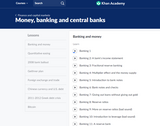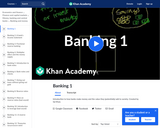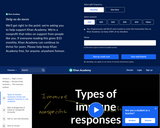
This lesson explains leverage and insolvency and why it is good or bad. [Banking, Money, Finance playlist: Lesson 10 of 24]
- Subject:
- Economics
- Social Science
- Material Type:
- Lecture
- Author:
- Salman Khan
- Date Added:
- 02/05/2019

This lesson explains leverage and insolvency and why it is good or bad. [Banking, Money, Finance playlist: Lesson 10 of 24]

This lesson tells how banks can give out loans without ever giving out gold. [Banking, Money, Finance playlist: Lesson 7 of 24]

This lesson talks about how money is created in a fractional reserve banking system. [Banking, Money, Finance playlist: Lesson 4 of 24]

This lesson talks about how money is created in a fractional reserve banking system. [Banking, Money, Finance playlist: Lesson 4 of 24]

This lesson explains reserve requirements and how they limit how much lending a bank can do. [Banking, Money, Finance playlist: Lesson 8 of 24]

This lesson introduces bank notes and how you are more familiar with them than you realize. [Banking, Money, Finance playlist: Lesson 5 of 24]

This lesson discusses government debt and treasuries. It explains what it means that Federal Reserve Notes are issued by the Reserve Bank but are not an obligation on the government. [Banking, Money, Finance playlist: Lesson 12 of 24]

This lesson introduces the ways that banks make money. [Banking, Money, Finance playlist: Lesson 1 of 24]

This lesson is an introduction to the income statement of a bank, and to income statements, in general. [Banking, Money, Finance playlist: Lesson 2 of 24]

This lesson discusses the idea of a reserve bank. [Banking, Money, Finance playlist: Lesson 11 of 24]

Overview: This lesson talks about the pros and cons of various banking systems and talks more about using gold as a standard. [Banking, Money, Finance playlist: Lesson 18 of 24]

This lesson explains the weak points of fractional reserve banking. [Banking, Money, Finance playlist: Lesson 22 of 24]

This lesson continues the discussion of fractional reserve banking. It further discusses the FDIC, deposit insurance and its side effects. [Banking, Money, Finance playlist: Lesson 23 of 24]

This lesson is a summary of thoughts of why Fractional Reserve Banking is a subsidy to banks and allows them to arbitrage the yield curve. [Banking, Money, Finance playlist: Lesson 24 of 24]

This course will examine the history of Western art from approximately 1600 to approximately 1800 period that bridges the gap from the Renaissance to the earliest days of the Modern era. Beginning with the Baroque in Counter-Reformation Italy and concluding with Neoclassicism in the late 18th century, the student will trace the stylistic developments in Europe and America through a variety of religious, political, and philosophical movements. Upon completion of this course, students will be able to: Identify works of art from the Baroque, Rococo, Enlightenment, and Neoclassical periods and be able to distinguish between these different periods; Discuss and identify the oeuvre of the major artists working in Western Europe from 1600-1800; Explain and identify the regional and cultural differences between works of art produced in the same period (i.e., Baroque, Rococo, Enlightenment, or Neoclassical); Recognize important works of art from the Baroque through Neoclassical periods, recalling such information as date of creation, artist, patron (if known), medium, and period; Recognize the features (stylistic and iconographic) typical of each period studied; Explain and discuss the general arc of Western history from approximately 1600-1800, as seen through the lens of the arts; Explain the forces influencing the change in style and subject matter in Western art from 1600-1800; Discuss the sources of influence (from previous historical periods as well as from neighboring geographical regions) that affected art produced from the Baroque to Neoclassical periods; Compare and contrast works of art from the Baroque through Neoclassical periods to those of other periods and cultures; Describe the methods and materials used to create works of art from the Baroque to Neoclassical periods; Explain the ways in which Baroque, Rococo, Enlightenment, and Neoclassical art reveal the social, religious, and political mores of their respective times and places. (Art History 207)

BPCC Open Campus - Math 097: Basic Mathematics is a review of basic mathematics skills. Here's what's covered: -fundamental numeral operations of addition, subtraction, multiplication division of whole numbers, fractions, and decimals -ratio and proportion -percent -systems of measurement -an introduction to geometry NOTE: Open Campus courses are non-credit reviews and tutorials and cannot be used to satisfy requirements in any curriculum at BPCC.

Design of shoreline protection along rivers, canals and the sea; load on bed and shoreline by currents, wind waves and ship motion; stability of elements under current and wave conditions; stability of shore protection elements; design methods, construction methods. Flow: recapitulation of basics from fluid mechanics (flow, turbulence), stability of individual grains (sand, but also rock) in different type of flow conditions (weirs, jets), scour and erosion. Porous Media: basic equation, pressures and velocities on the stability on the boundary layer; groundwater flow with impermeable and semi-impermeable structures; granular filters and geotextiles. Waves: recapitulation of the basics of waves, focus on wave forces on the land-water boundary, specific aspects of ship induced waves, stability of elements under wave action (loose rock, placed blocks, impermeable layers) Design: overview of the various types of protections, construction and maintenance; design requirements, deterministic and probabilistic design; case studies, examples Materials and environment: overview of materials to be used, interaction with the aquatic environment, role of the land-water boundary as part of the ecosystem; environmentally sound shoreline design.

In this beginning algebra course, you'll learn about
fundamental operations on real numbers
exponents
solving linear equations and inequalities
applications
functions
graphing linear equations
slope
systems of linear equations

This 8-minute video lesson presents an overview of types of immune responses. It looks at the difference between innate and adaptive immunity and the differences between humoral adaptive immunity and cell-mediated adaptive immunity. [Biology playlist: Lesson 52 of 71].

This course serves as an introduction to the Buddhist artistic traditions of South, Southeast, and East Asia, as well as the Himalayas. It starts with the core tenets of Buddhism, Buddhist iconography, and early Buddhist art and architecture in India, then progresses to Southeast Asia. The course then focuses on Vajrayana Buddhism and its artistic traditions in the Himalayas, then examines Mahayana Buddhist art and architecture in China, Korea and Japan. Upon successful completion of this course, students will be able to: identify the core beliefs of Buddhism, major Buddhist schools, and basic Buddhist iconography; identify major works of Buddhist art and Buddhist monuments from South, Southeast, and East Asia, as well as the Himalayas; identify the major developments in Buddhist doctrine and Buddhist art and architecture, as well as the relationship between the two as the religion spread throughout Southeast Asia, East Asia, and the Himalayas. (Art History 406)